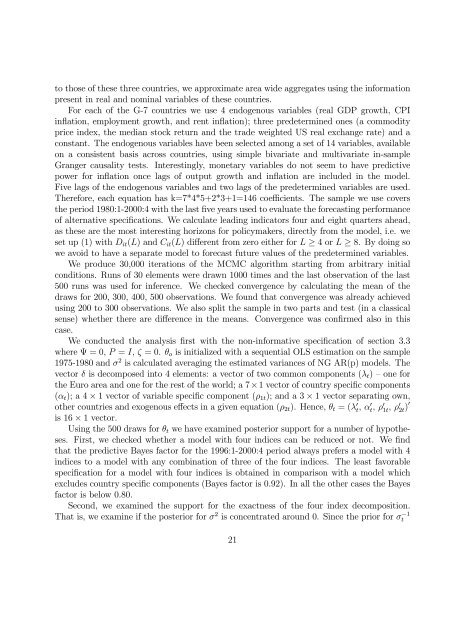PANEL INDEX VAR MODELS: SPECIFICATION, ESTIMATION - Ivie
Create successful ePaper yourself
Turn your PDF publications into a flip-book with our unique Google optimized e-Paper software.
to those of these three countries, we approximate area wide aggregates using the information<br />
present in real and nominal variables of these countries.<br />
For each of the G-7 countries we use 4 endogenous variables (real GDP growth, CPI<br />
inflation, employment growth, and rent inflation); three predetermined ones (a commodity<br />
price index, the median stock return and the trade weighted US real exchange rate) and a<br />
constant. The endogenous variables have been selected among a set of 14 variables, available<br />
on a consistent basis across countries, using simple bivariate and multivariate in-sample<br />
Granger causality tests. Interestingly, monetary variables do not seem to have predictive<br />
power for inflation once lags of output growth and inflation are included in the model.<br />
Five lags of the endogenous variables and two lags of the predetermined variables are used.<br />
Therefore, each equation has k=7*4*5+2*3+1=146 coefficients. The sample we use covers<br />
the period 1980:1-2000:4 with the last five years used to evaluate the forecasting performance<br />
of alternative specifications. We calculate leading indicators four and eight quarters ahead,<br />
as these are the most interesting horizons for policymakers, directly from the model, i.e. we<br />
set up (1) with D it (L) andC it (L) different from zero either for L ≥ 4orL ≥ 8. By doing so<br />
we avoid to have a separate model to forecast future values of the predetermined variables.<br />
We produce 30,000 iterations of the MCMC algorithm starting from arbitrary initial<br />
conditions. Runs of 30 elements were drawn 1000 times and the last observation of the last<br />
500 runs was used for inference. We checked convergence by calculating the mean of the<br />
draws for 200, 300, 400, 500 observations. We found that convergence was already achieved<br />
using 200 to 300 observations. We also split the sample in two parts and test (in a classical<br />
sense) whether there are difference in the means. Convergence was confirmed also in this<br />
case.<br />
We conducted the analysis first with the non-informative specification of section 3.3<br />
where Ψ =0,P = I, ζ =0. θ o is initialized with a sequential OLS estimation on the sample<br />
1975-1980 and σ 2 is calculated averaging the estimated variances of NG AR(p) models. The<br />
vector δ is decomposed into 4 elements: a vector of two common components (λ t )—onefor<br />
the Euro area and one for the rest of the world; a 7×1 vector of country specific components<br />
(α t ); a 4 × 1 vector of variable specific component(ρ 1t ); and a 3 × 1 vector separating own,<br />
other countries and exogenous effects in a given equation (ρ 2t ). Hence, θ t =(λ t, α t, ρ 1t, ρ 2t) <br />
is 16 × 1 vector.<br />
Usingthe500drawsforθ t we have examined posterior support for a number of hypotheses.<br />
First, we checked whether a model with four indices can be reduced or not. We find<br />
that the predictive Bayes factor for the 1996:1-2000:4 period always prefers a model with 4<br />
indices to a model with any combination of three of the four indices. The least favorable<br />
specification for a model with four indices is obtainedincomparisonwithamodelwhich<br />
excludes country specific components (Bayes factor is 0.92). In all the other cases the Bayes<br />
factor is below 0.80.<br />
Second, we examined the support for the exactness of the four index decomposition.<br />
That is, we examine if the posterior for σ 2 is concentrated around 0. Since the prior for σ −1<br />
t<br />
21

















